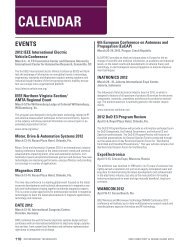Simple Method for Predicting a Cable Shielding Factor, Based on ...
Simple Method for Predicting a Cable Shielding Factor, Based on ...
Simple Method for Predicting a Cable Shielding Factor, Based on ...
You also want an ePaper? Increase the reach of your titles
YUMPU automatically turns print PDFs into web optimized ePapers that Google loves.
S impl e Me t h o d f o r Predic t ing a c a bl e Shi e l ding Fa c t o r / M a rdigui a n<br />
shielding<br />
<str<strong>on</strong>g>Simple</str<strong>on</strong>g> <str<strong>on</strong>g>Method</str<strong>on</strong>g> <str<strong>on</strong>g>for</str<strong>on</strong>g> <str<strong>on</strong>g>Predicting</str<strong>on</strong>g><br />
a <str<strong>on</strong>g>Cable</str<strong>on</strong>g> <str<strong>on</strong>g>Shielding</str<strong>on</strong>g> <str<strong>on</strong>g>Factor</str<strong>on</strong>g>,<br />
<str<strong>on</strong>g>Based</str<strong>on</strong>g> <strong>on</strong> Transfer Impedance<br />
MICHEL MARDIGUIAN<br />
EMC C<strong>on</strong>sultant<br />
St. Remy les Chevreuse, France<br />
For a shielded cable, an approximate<br />
relati<strong>on</strong>ship valid from few kHz up<br />
to the first cable res<strong>on</strong>ance can be<br />
derived from its Transfer Impedance (Zt )<br />
allowing to predict the cable shielding factor.<br />
This <str<strong>on</strong>g>Cable</str<strong>on</strong>g> <str<strong>on</strong>g>Shielding</str<strong>on</strong>g> factor, as a figure<br />
of merit, is often preferred by engineers<br />
dealing with product specificati<strong>on</strong>s and<br />
early design. Being not necessarily EMC<br />
specialists, they can relate it directly to the<br />
overall shielding per<str<strong>on</strong>g>for</str<strong>on</strong>g>mance required <str<strong>on</strong>g>for</str<strong>on</strong>g><br />
a system boxes or cabinets.<br />
This article comes up with very simple,<br />
practical <str<strong>on</strong>g>for</str<strong>on</strong>g>mulas, that directly express<br />
the cable shielding factor Kr, given its Zt<br />
and frequency.<br />
INTRODUCTION<br />
Expressing the effectiveness of a cable<br />
shield has been a recurrent c<strong>on</strong>cern am<strong>on</strong>g<br />
the EMC Community, and more generally<br />
<str<strong>on</strong>g>for</str<strong>on</strong>g> the whole Electr<strong>on</strong>ic industry. This<br />
comes from a legitimate need to predict,<br />
measure, compare and improve the efficiency<br />
<str<strong>on</strong>g>for</str<strong>on</strong>g> a wide variety of shielded cables<br />
like coaxial cables or shielded pairs and<br />
bundles, having themselves various types<br />
of screens: braids, foils, spiral, corrugated,<br />
woven etc .<br />
However, when it comes to decide<br />
what would be a c<strong>on</strong>venient, trustworthy<br />
characteristic <str<strong>on</strong>g>for</str<strong>on</strong>g> a cable shield, several<br />
methods are in competiti<strong>on</strong>: <str<strong>on</strong>g>Shielding</str<strong>on</strong>g><br />
Effectiveness (SE,dB), Surface Transfer (<br />
Zt, Ohm/m) or Screen Reducti<strong>on</strong> <str<strong>on</strong>g>Factor</str<strong>on</strong>g><br />
(Kr, dB).<br />
Although Transfer Impedance Zt is a<br />
widely used and dependable parameter,<br />
SE or Reducti<strong>on</strong> <str<strong>on</strong>g>Factor</str<strong>on</strong>g> Kr as a figure of<br />
merit are often preferred by engineers<br />
dealing with product specificati<strong>on</strong>s and<br />
overall design, because they can relate<br />
it directly to the whole shielding per<str<strong>on</strong>g>for</str<strong>on</strong>g>mance<br />
required <str<strong>on</strong>g>for</str<strong>on</strong>g> the system. It would<br />
be a n<strong>on</strong>sense to require 60dB of shielding<br />
<str<strong>on</strong>g>for</str<strong>on</strong>g> a system boxes or cabinets if the associated<br />
cables and their c<strong>on</strong>necting hardware<br />
provide <strong>on</strong>ly 30dB, and vice-versa.<br />
a) <str<strong>on</strong>g>Shielding</str<strong>on</strong>g> Effectiveness, as defined<br />
<str<strong>on</strong>g>for</str<strong>on</strong>g> any shielding barrier is given by:<br />
SE (dB) = 20 log [E ( or H) without<br />
shield] / [ E ( or H) with shield]<br />
By illuminating the tested sample with a<br />
str<strong>on</strong>g electromagnetic field, this approach<br />
is coherent with <str<strong>on</strong>g>Shielding</str<strong>on</strong>g> Effectiveness<br />
definiti<strong>on</strong> <str<strong>on</strong>g>for</str<strong>on</strong>g> a box, a cabinet or any enclosure,<br />
with SE being a dimensi<strong>on</strong>less<br />
number. Since it would be unpractical to<br />
access the remaining E (or H) field inside a<br />
cable shield, meaning between the sheath<br />
and the core, it is the effect of this incident<br />
field that is measured instead, <str<strong>on</strong>g>for</str<strong>on</strong>g> instance<br />
the core-to-shield voltage.<br />
However, there are several drawbacks<br />
to this method:<br />
• It requires a full range of expensive<br />
instrumentati<strong>on</strong> : generator, power<br />
1 interference technology emc Directory & design guide 2012
S impl e Me t h o d f o r Predic t ing a c a bl e Shi e l ding Fa c t o r / M a rdigui a n<br />
shielding<br />
amplifier, antennas, shielded/ anechoic room (or<br />
stirred mode reverberating chamber) etc ...<br />
• It carries the typical uncertainties of radiated<br />
measurements ( mean value <str<strong>on</strong>g>for</str<strong>on</strong>g> ordinary radiated<br />
EMI test uncertainty being 6dB)<br />
• It is very sensitive to the tested cable set-up: height<br />
above ground, terminati<strong>on</strong> loads and type of excitati<strong>on</strong><br />
in near field c<strong>on</strong>diti<strong>on</strong>s. For instance, a<br />
transmit antenna at 1m from the test sample will<br />
create near field c<strong>on</strong>diti<strong>on</strong>s <str<strong>on</strong>g>for</str<strong>on</strong>g> all frequencies below<br />
50MHz. If the antenna is of the dipole family,<br />
the near-field will be predominantly Electrical, i.e.<br />
a high-impedance field and the SE results will look<br />
excellent. If the transmit antenna is a magnetic<br />
loop, the field will be a low-impedance H field, and<br />
the SE results will be much less impressive.<br />
b) Transfer Impedance (Zt), in c<strong>on</strong>trast to SE, is a<br />
purely c<strong>on</strong>ducted measurement method, with accurate<br />
results, typically within 10% (1dB) uncertainty. But Zt, being<br />
in Ohm/meter has a dimensi<strong>on</strong> and cannot be directly<br />
figured as a shield per<str<strong>on</strong>g>for</str<strong>on</strong>g>mance .<br />
c) Shield Reducti<strong>on</strong> <str<strong>on</strong>g>Factor</str<strong>on</strong>g>, Kr rec<strong>on</strong>ciles the two<br />
methods, by using the best of Zt - the benefit of a c<strong>on</strong>ducted<br />
measurement, and of SE : the commodity of a<br />
direct figure in dB.<br />
Definiti<strong>on</strong> of the Shield Reducti<strong>on</strong> <str<strong>on</strong>g>Factor</str<strong>on</strong>g><br />
We can define Shield Reducti<strong>on</strong> factor (Kr) as the ratio<br />
of the Differential Mode Voltage (Vd) appearing, core-to<br />
shield at the receiving end of the cable, to the Comm<strong>on</strong><br />
Mode Voltage (Vcm) applied in series into the loop (Figure<br />
1).<br />
Kr (dB) = 20 log (Vd / Vcm) (1)<br />
This figure could also be regarded as the Mode C<strong>on</strong>versi<strong>on</strong><br />
Ratio between the external circuit (the loop) and the<br />
internal <strong>on</strong>e ( the core-to-shield line).<br />
Slightly different versi<strong>on</strong>s of this definiti<strong>on</strong> are sometimes<br />
used like:<br />
Kr (dB) = 20 Log (Vd 2<br />
/ Vd 1<br />
)<br />
Where,<br />
Vd 1<br />
: differential voltage at the receive end when the<br />
shield is not there (disc<strong>on</strong>nected)<br />
Vd 2<br />
: differential voltage at the receive end with the<br />
shield normally grounded, both ends.<br />
This latter definiti<strong>on</strong> would be more rigorous, somewhat<br />
reminiscent of the Inserti<strong>on</strong> Loss used in EMC<br />
terminology, i.e. it compares what <strong>on</strong>e would get without<br />
and with the shield, <str<strong>on</strong>g>for</str<strong>on</strong>g> a same excitati<strong>on</strong> voltage ( see<br />
Fig. 1, B). This eliminates the c<strong>on</strong>tributi<strong>on</strong> of the core<br />
wire resistance and self-inductance, since they influence<br />
identically Vd 1<br />
and Vd 2<br />
.<br />
Calculated Values of Kr <str<strong>on</strong>g>for</str<strong>on</strong>g> simple<br />
cases, <str<strong>on</strong>g>for</str<strong>on</strong>g> length ι < λ/2<br />
Let express Vd, using the classical Zt model, assuming<br />
that the near end of the cable is shorted (core -to-shield) :<br />
Vd = Zt x l x I shield<br />
where l : length of the shielded cable<br />
Expressing the shield current, I shield<br />
:<br />
I shield<br />
= Vcm / Z loop<br />
We can replace Vd by its value in the expressi<strong>on</strong> of Kr:<br />
Kr = Zt.l / Z loop<br />
Z loop<br />
itself is a length-dependent term, since it is simply<br />
the impedance of the shield-to-ground loop, which <str<strong>on</strong>g>for</str<strong>on</strong>g> any<br />
decent shield is a lesser value than that of the core wire<br />
plus the terminal impedances.<br />
Z loop<br />
(Ω) = ( R sh<br />
+ jω. L ext<br />
) . l<br />
where,<br />
R sh<br />
= shield resistance<br />
L ext<br />
= self-inductance of the shield-toground<br />
loop<br />
Replacing Z loop<br />
by its expressi<strong>on</strong>:<br />
Zt (Fig. 2) c<strong>on</strong>sists in shield resistance R sh<br />
and shield<br />
transfer (or leakage) inductance Lt.<br />
Thus, we reach an expressi<strong>on</strong> <str<strong>on</strong>g>for</str<strong>on</strong>g> Kr as a dimensi<strong>on</strong>less<br />
number, independent of the cable length:<br />
This expressi<strong>on</strong> is interesting in that it reveals three<br />
basic frequency domains:<br />
a) <str<strong>on</strong>g>for</str<strong>on</strong>g> Very Low Freq., where the term ωLt is negligible,<br />
Zt is dominated by R sh<br />
:<br />
Kr = R sh<br />
/ ( R sh<br />
+ jω. L ext<br />
)<br />
≈ 1 (0dB) below few kHz, since the lower term, loop<br />
impedance reduces to Rs sh<br />
b) at medium frequencies ( typically above 5-10kHz<br />
<str<strong>on</strong>g>for</str<strong>on</strong>g> ordinary braided shield) :<br />
Kr = ( R sh<br />
+ jω. Lt ) / ( jω. L ext<br />
)<br />
Reducti<strong>on</strong> <str<strong>on</strong>g>Factor</str<strong>on</strong>g> improves linearly with frequency<br />
c) at higher frequencies (typically above <strong>on</strong>e MHz),<br />
up to first < λ/2 res<strong>on</strong>ance :<br />
Kr = Lt / L ext<br />
The Reducti<strong>on</strong> <str<strong>on</strong>g>Factor</str<strong>on</strong>g> stays c<strong>on</strong>stant , independent of<br />
length and frequency.<br />
A quick, handy <str<strong>on</strong>g>for</str<strong>on</strong>g>mula can be derived, which is valid<br />
<str<strong>on</strong>g>for</str<strong>on</strong>g> any frequency from 10kHz up to first < λ/2 res<strong>on</strong>ance :<br />
Kr (dB) = - 20 Log [ 1 + (6. FMHz /Zt (Ω/m) ] (3)<br />
The value <str<strong>on</strong>g>for</str<strong>on</strong>g> Zt being that taken at the frequency of<br />
c<strong>on</strong>cern.<br />
(2)<br />
2 interference technology emc Directory & design guide 2012
S impl e Me t h o d f o r Predic t ing a c a bl e Shi e l ding Fa c t o r / M a rdigui a n<br />
shielding<br />
Figure 1. C<strong>on</strong>ceptual view of the shield Reducti<strong>on</strong> <str<strong>on</strong>g>Factor</str<strong>on</strong>g> (Kr), with<br />
two variati<strong>on</strong>s of the measurement set-up. In (B), the measurement<br />
compares the voltage measured at the terminati<strong>on</strong> with, and<br />
without the shield c<strong>on</strong>nected.<br />
(*) Several <str<strong>on</strong>g>for</str<strong>on</strong>g>mulas have been proposed in the past <str<strong>on</strong>g>for</str<strong>on</strong>g> expressing<br />
a cable shield effectiveness based <strong>on</strong> its Zt. An often<br />
menti<strong>on</strong>ed quick-rule is : Kr (or SE) dB = 40 - 20 Log ( Zt. l) .<br />
Although it are correct above the ohmic regi<strong>on</strong> of Zt, it can give<br />
widely optimistic results, like 50dB or 70dB at 50/60Hz where<br />
an ordinary shield has no effect at all against Comm<strong>on</strong> Mode<br />
induced Interference.<br />
Calculati<strong>on</strong> of Kr when length is<br />
approaching or exceeding λ/2<br />
When the dimensi<strong>on</strong> of the cable reaches a half-wave<br />
length, <strong>on</strong>e cannot keep multiplying Zt(Ω/m) by a physical<br />
length which is no l<strong>on</strong>ger carrying a uni<str<strong>on</strong>g>for</str<strong>on</strong>g>m current.<br />
In fact, the “electrically short line” assumpti<strong>on</strong> becomes<br />
progressively less and less acceptable when cable length<br />
“l” exceeds λ/10 .<br />
With the cable being exposed to a uni<str<strong>on</strong>g>for</str<strong>on</strong>g>m electromagnetic<br />
field or to an evenly distributed ground shift,<br />
a typical case with CM interference, the shield grounded<br />
both ends behaves as a dipole exhibiting self-res<strong>on</strong>ance<br />
and anti-res<strong>on</strong>ance <str<strong>on</strong>g>for</str<strong>on</strong>g> every odd and even multiple of λ/2,<br />
respectively. Accordingly, current peaks will take place<br />
periodically <str<strong>on</strong>g>for</str<strong>on</strong>g> every odd multiple of λ/2, resulting in a<br />
worst-case value of Kr.<br />
*Some tests set-up <str<strong>on</strong>g>for</str<strong>on</strong>g> measuring Kr are based <strong>on</strong> end-driving<br />
of the cable shield by a 50Ω generator, which introduces also<br />
λ/4 res<strong>on</strong>ances. A quick discussi<strong>on</strong> <strong>on</strong> this artefact is presented<br />
in Appendix .<br />
One must also take into account C’, the actual propagati<strong>on</strong><br />
speed in the cable-to-ground transmissi<strong>on</strong> line, where<br />
C’ is slower than the ideal free-space velocity C. Typically<br />
C’ = 0.7 to 0.8 C. There<str<strong>on</strong>g>for</str<strong>on</strong>g>e, the actual wavelength in the<br />
cable to ground loop is :<br />
λ’ = 0.7 to 0.8 x λ<br />
If we align our calculati<strong>on</strong>s to the most detrimental<br />
c<strong>on</strong>diti<strong>on</strong>s, the worst is reached (Figure 3) at the first<br />
λ’/2 where the received voltage Vd is maximum (due to<br />
a current peak) resulting in a low value <str<strong>on</strong>g>for</str<strong>on</strong>g> Kr. This is<br />
translating correctly the actual situati<strong>on</strong> where, <str<strong>on</strong>g>for</str<strong>on</strong>g> a<br />
uni<str<strong>on</strong>g>for</str<strong>on</strong>g>m field exposure, the victim receiver circuit will<br />
Figure 2. Some typical values of Zt <str<strong>on</strong>g>for</str<strong>on</strong>g> several shielded cables.<br />
see a higher interference.<br />
Bey<strong>on</strong>d this first res<strong>on</strong>ance point, <str<strong>on</strong>g>for</str<strong>on</strong>g> a c<strong>on</strong>stant CM<br />
excitati<strong>on</strong>, the terminati<strong>on</strong> voltage Vd will run through a<br />
successi<strong>on</strong> of peaks ( at odd multiples of λ’/2) and nulls.<br />
Yet, the amplitude of the peaks will not exceed that<br />
reached at first res<strong>on</strong>ance.<br />
Simply c<strong>on</strong>sidering that the length of “electrically<br />
active” shield segment is limited to λ’/2, Vd max<br />
can be<br />
predicted as follows:<br />
Vd max<br />
= Zt (Ω/m) x 0.5 λ’ x I shield<br />
(4)<br />
where,<br />
Zt = transfer impedance at frequency of c<strong>on</strong>cern corresp<strong>on</strong>ding<br />
to λ’. At such frequency, Zt is dominated by<br />
Lt, the shield transfer inductance<br />
λ’= corrected wavelength <str<strong>on</strong>g>for</str<strong>on</strong>g> propagati<strong>on</strong> speed C’ ≈<br />
0.7 to 0.8 λ<br />
λ’= 0.75 . 300.10 6 / F(Hz) = 220.10 6 / F(Hz) (average<br />
value)<br />
(Eq .4) <str<strong>on</strong>g>for</str<strong>on</strong>g> Vd (max) can be rewritten as:<br />
Vd max<br />
= Lt. ω . 0.5 . ( 220.10 6 / F ) x I sh<br />
= Lt( H/m). 2π . F. 0.5 . ( 220.10 6 / F ) x I sh<br />
)<br />
Frequency cancels-out in the equati<strong>on</strong>, so reducing<br />
all the variables and using more practical units like Lt<br />
in nH/m :<br />
Vd max<br />
≈ Lt (nH/m) x 0.7 x I sh<br />
(5)<br />
We can furthermore express I sh<br />
max <str<strong>on</strong>g>for</str<strong>on</strong>g> a shield grounded<br />
both ends illuminated by a uni<str<strong>on</strong>g>for</str<strong>on</strong>g>m field ( typical EMI<br />
susceptibility scenario) :<br />
I sh (max)<br />
= I loop (max)<br />
= Vcm max<br />
) / Zc<br />
where,<br />
Zc = characteristic impedance of cable-above-ground<br />
transmissi<strong>on</strong> line<br />
= 150Ω <str<strong>on</strong>g>for</str<strong>on</strong>g> a height/diam ratio = 4 ( typical of MIL-<br />
STD 461 test set-up)<br />
= 300Ω <str<strong>on</strong>g>for</str<strong>on</strong>g> a height/diam ratio = 50<br />
Thus, Zc can be given an average value of 210Ω ( a +<br />
/- 3dB approximati<strong>on</strong>)<br />
Combining Eq. 4 and 5 we get a simple expressi<strong>on</strong> <str<strong>on</strong>g>for</str<strong>on</strong>g><br />
3 interference technology emc Directory & design guide 2012
S impl e Me t h o d f o r Predic t ing a c a bl e Shi e l ding Fa c t o r / M a rdigui a n<br />
shielding<br />
Figure 4. Calculated results <str<strong>on</strong>g>for</str<strong>on</strong>g> a 5m l<strong>on</strong>g single braid coaxial.<br />
First λ’/2 res<strong>on</strong>ance is reached around 20MHz.<br />
Figure 3. C<strong>on</strong>ceptual view of the Kr behavior above res<strong>on</strong>ance. Even<br />
with a good quality shield, the periodic shield current humps at odd<br />
multiples λ’/2 account <str<strong>on</strong>g>for</str<strong>on</strong>g> a typical 10dB deteriorati<strong>on</strong> of Kr<br />
worst case Kr above res<strong>on</strong>ance:<br />
Kr (min) = Vd max / Vcm<br />
= ( 0.7 Lt . Vcm / 210) / Vcm<br />
Kr min (dB) = - 20 Log [ 210 / 0.7 Lt(nH/m) ]<br />
Kr min (dB) = - 20 Log [ 300 / Lt(nH/m) ] (6)<br />
A Few Practical Results <str<strong>on</strong>g>for</str<strong>on</strong>g> Kr, below<br />
and above first cable res<strong>on</strong>ance<br />
The following figures show some calculati<strong>on</strong>s using<br />
the <str<strong>on</strong>g>for</str<strong>on</strong>g>mulas of this article, and test results.<br />
Figure 4 shows calculated results <strong>on</strong> a 5m l<strong>on</strong>g good<br />
quality single braid coaxial cable, 1 meter above ground,<br />
with perfect 360° c<strong>on</strong>tact at c<strong>on</strong>nector backshell. On<br />
Figure 5, the curve shows the test results of a 5m coaxial<br />
cable where the shield has been is intenti<strong>on</strong>ally spoiled<br />
by a 10cm pigtail. The deteriorati<strong>on</strong> of Kr above 8 MHz<br />
is spectacular.<br />
Appendix<br />
We have seen that when dimensi<strong>on</strong> of the cable approaches,<br />
or exceeds a half-wave length, the current <strong>on</strong> the shield follows<br />
a sinusoidal distributi<strong>on</strong> with alternating phase reversals<br />
every λ/2 segment. This is complicated by the fact that, if<br />
the test set-up is based <strong>on</strong> a 50Ω generator driving <strong>on</strong>e end of<br />
the shield, this latter appears as a transmissi<strong>on</strong> line shorted<br />
at the other end, subject to standing waves. This mismatch<br />
causes nulls and peaks of current at every multiple of λ/4.<br />
For the odd multiples like λ/4, 3 λ/4, 5λ/4 … etc., the<br />
null of current corresp<strong>on</strong>d to the generator seeing an infinite<br />
impedance. While the driving voltage is equal to the<br />
open-circuit value, the current minimum <strong>on</strong> the shield<br />
is causing a drop in the terminal voltage Vd, there<str<strong>on</strong>g>for</str<strong>on</strong>g>e the<br />
value of Kr artificially jumps to higher values. This effect is<br />
Figure 5. Kr <str<strong>on</strong>g>for</str<strong>on</strong>g> a 5m coaxial, shield grounded with 10cm pigtail<br />
(courtesy of AEMC Grenoble, France ).<br />
Figure 6. Kr <str<strong>on</strong>g>for</str<strong>on</strong>g> 5m shielded computer cable, with good quality<br />
SubD25 shielded c<strong>on</strong>nector (courtesy AEMC Grenoble, France)<br />
4 interference technology emc Directory & design guide 2012
S impl e Me t h o d f o r Predic t ing a c a bl e Shi e l ding Fa c t o r / M a rdigui a n<br />
shielding<br />
visible <strong>on</strong> the figures, where Kr appears periodically better,<br />
then worse, than its average values. In the present paper, we<br />
have preferred to align the calculati<strong>on</strong>s <strong>on</strong> the worst case<br />
situati<strong>on</strong>, not the most favorable <strong>on</strong>e.<br />
Michel Mardiguian, IEEE Senior Member, graduated electrical engineer<br />
BSEE, MSEE, born in Paris, 1941. While working at IBM in France, he started<br />
his EMC career in 1974 as the local IBM EMC specialist, having close ties<br />
with his US counterparts at IBM/Kingst<strong>on</strong>, USA. From 1976 to 80, he was<br />
also the French delegate to the CISPR Working Group , participating to what<br />
became CISPR 22, the root document <str<strong>on</strong>g>for</str<strong>on</strong>g> FCC 15-J and European EN55022. In<br />
1980, he joined D<strong>on</strong> White C<strong>on</strong>sultants (later re-named ICT) in Gainesville,<br />
Virginia, becoming Director of Training, then VP Engineering. He developed<br />
the market of EMC seminars, teaching himself more than 160 classes in the<br />
US and worldwide. Established since 1990 as a private c<strong>on</strong>sultant in France,<br />
teaching EMI / RFI / ESD classes and working <strong>on</strong> c<strong>on</strong>sulting tasks from EMC<br />
design to firefighting. One top involvement has been the EMC of the Channel<br />
Tunnel, with his British colleagues of Interference Technology Internati<strong>on</strong>al.<br />
He has authored eight widely sold handbooks, two books co-authored<br />
with D<strong>on</strong> White and 28 papers presented at IEEE and Zurich EMC<br />
Symposia, and various c<strong>on</strong>ferences. He is also a semi-professi<strong>on</strong>al musician,<br />
bandleader of the CLARINET CONNECTION Jazz Group.<br />
C<strong>on</strong>tact Mardiguian at m.mardiguian@orange.fr<br />
5 interference technology emc Directory & design guide 2012


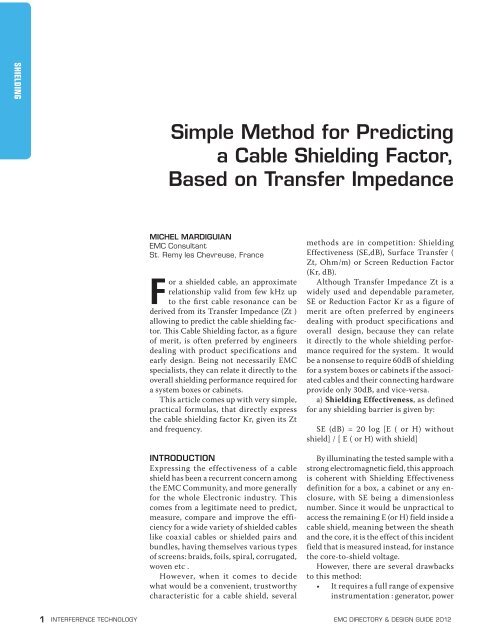

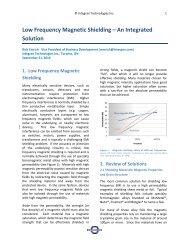

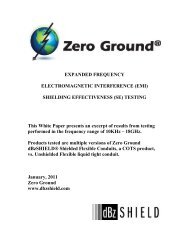
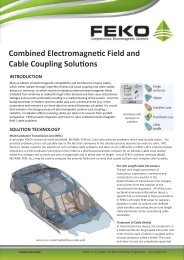

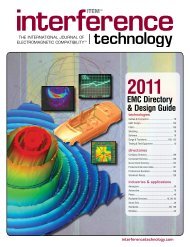

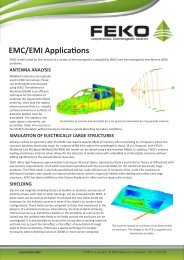
![[ thursday ] morning sessions 8:30 am-noon - Interference Technology](https://img.yumpu.com/23176841/1/190x247/-thursday-morning-sessions-830-am-noon-interference-technology.jpg?quality=85)
